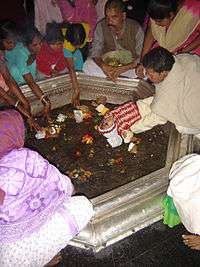Vishnupad Mandir
| Vishnupada Mandir | |
|---|---|
 | |
 Vishnupada Mandir Location in Bihar | |
| Name | |
| Proper name | Vishnupada Mandir |
| Geography | |
| Coordinates | 24°36′37″N 85°0′33″E / 24.61028°N 85.00917°ECoordinates: 24°36′37″N 85°0′33″E / 24.61028°N 85.00917°E |
| Country | India |
| State | Bihar |
| Location | Gaya |
| Culture | |
| Primary deity | Lord Vishnu |
| Architecture | |
| Architectural styles | Shikhara |
| History and governance | |
| Date built | 1787[1] |
| Creator | Queen Ahilya Bai Holkar of Indore [2] |
Vishnupada Mandir (Hindi: विष्णुपद मंदिर) is an ancient temple in Gaya, India. It is a Hindu temple, dedicated to Lord Vishnu.
This temple is located along the Falgu River, marked by a footprint of Lord Vishnu known as Dharmasila, incised into a block of basalt. The Bhumihar Brahmins have been the traditional priests at Vishnupad Mandir in Gaya as Gayawal Pandas and in the adjoining districts like Hazaribagh.[3] Several legendary saints as Ramanujacharya, Madhvacharya, Sankaradeva and Chaitanya Mahaprabhu have visited this shrine.

History and location
The construction date of temple is unknown and it is believed that Rama along with Sita had visited this place.[4] The present day structure was rebuilt by Devi Ahilya Bai Holkar, the ruler of Indore, in 1787,[5] on the banks of the Falgu river. A flight of 1000 stone steps leads to the top of the Brahmajuni hill, 1 km southwest of the Vishnupad mandir. Visitors prefer to go to the top of Brahmajuni hill see magnificent view of temple from top.[6] There are many small temples near this temple.[7]
Once a demon known as Gayasura, did a heavy penance and sought a boon that whoever see him should attain salvation (Moksham). Since salvation is achieved through being righteous in one's lifetime, people started obtaining it easily. To prevent immoral people from attaining salvation Lord Vishnu asked Gayasura to go beneath the earth and did so by placing his right foot on asura's head. After pushing Gayasura below the surface of earth, Lord Vishnu's foot print remained on the surface that we see even today. The footprint consists of nine different symbols including Shankam, Chakram and Gadham. These are believed to be weapons of the lord. Gayasura now pushed into earth pleaded for food. Lord Vishnu gave him a boon that every day, someone will offer him food. Whoever does so, their souls will reach heaven. The day Gayasura doesn't get food, it is believed that he will come out. Every day, one or the other from different parts of India will pray for welfare of his departed and offer food, feeding Gayasura.
On top of the temple is a gold flag weighing approx 51kg. Inside the temple is a (Garv ghiri ) a silver coated hexagon railing also known as (pahal).
Architecture
This is believed that the temple was built with the footprints of Lord Vishnu in the centre.[8] In Hinduism, this footprint marks the act of Lord Vishnu subduing Gayasur by placing his foot on his chest. Inside the Vishnupad Mandir, the 40 cm long footprint of Lord Vishnu is imprinted in solid rock and surrounded by a silver plated basin.[9] The height of this temple is 30 meters and it a has 8 rows of beautifully carved pillars which support the pavilion.[10] The temple is built of large gray granite blocks jointed with iron clamps. The octagonal shrine faces east. Its pyramidal tower rises up a 100 feet. The tower has sloping sides with alternately indented and plain sections. The sections are set at an angle to create a series of peaks joined at the top.[11] Within the temple stands the immortal banyan tree Akshayabat where the final rituals for the dead takes place.
Mythology
- This place is also believed to be the one under which the Lord Buddha meditated for six years.[12]
- Inside the Vishnupada Mandir, the 40 cm long footprint of Lord Vishnu is imprinted on solid rock and surrounded by a silver-plated basin.[13]
- There is a gold flag and couple of Kalash made of gold has been embedded at the top of the temple which use to always glitter. It is said that long ago two thieves tried to steal the golden flag and the kalash from the top of the temple, but one thief became stone at the top of the temple and the other became stone as he fell to the ground. The stone of the thieves still remains on public view (it is not a man shape but a flat shape of the thieves).
See also
References
- ↑ http://www.indovacations.net/english/Aboutgaya.htm
- ↑ http://www.indovacations.net/english/Aboutgaya.htm
- ↑ {{cite book Janshruti }}
- ↑ http://gaya.bih.nic.in/html/history.htm
- ↑ http://www.indovacations.net/english/Aboutgaya.htm
- ↑ http://www.tourisminbihar.com/gaya/vishnupad-temple.html
- ↑ http://www.indnav.com/servlet/Browse?mt=goToName&name=Vishnupad+Temple
- ↑ http://www.indnav.com/servlet/Browse?mt=goToName&name=Vishnupad+Temple
- ↑ "Archived copy". Archived from the original on September 24, 2009. Retrieved December 26, 2009.
- ↑ http://www.indovacations.net/english/Aboutgaya.htm
- ↑ Vishnupaada Temple—-India9.com
- ↑ http://www.indovacations.net/english/Aboutgaya.htm
- ↑ http://www.tourisminbihar.com/gaya/vishnupad-temple.html
External links
| Wikimedia Commons has media related to Vishnupad Mandir. |